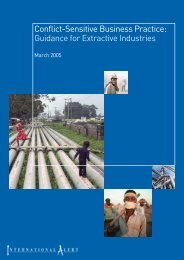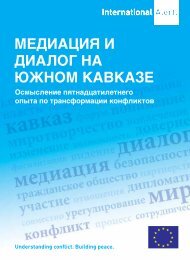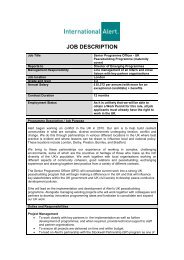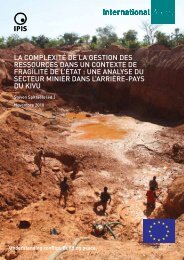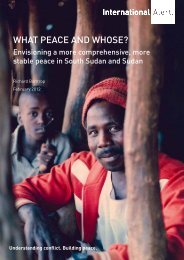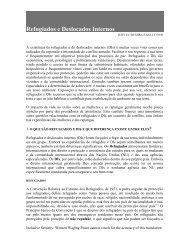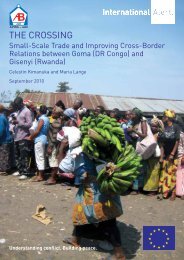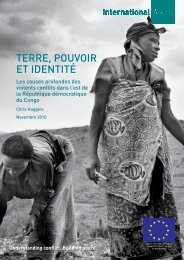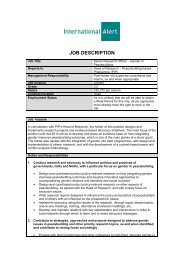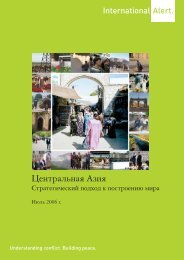Walking in the Dark: informal Cross-border trade ... - International Alert
Walking in the Dark: informal Cross-border trade ... - International Alert
Walking in the Dark: informal Cross-border trade ... - International Alert
You also want an ePaper? Increase the reach of your titles
YUMPU automatically turns print PDFs into web optimized ePapers that Google loves.
20 <strong>International</strong> <strong>Alert</strong><br />
3.2 Trade flows<br />
The volumes and types of <strong>trade</strong> are not <strong>the</strong> same at all <strong>the</strong> <strong>border</strong> locations chosen for this study:<br />
<strong>the</strong> number of <strong>trade</strong>rs, <strong>the</strong> type and value of <strong>the</strong> products be<strong>in</strong>g <strong>trade</strong>d, and <strong>the</strong> proportion of men<br />
and women <strong>trade</strong>rs all vary. The recorded data for <strong>trade</strong>r numbers allow us to analyse <strong>the</strong> number<br />
of <strong>trade</strong>rs who cross <strong>the</strong> <strong>border</strong> each day and compare <strong>the</strong> number of “significant products”<br />
(those recorded at least 10 times dur<strong>in</strong>g <strong>the</strong> 14 days of count<strong>in</strong>g). 32<br />
Trade flows are higher from Cyangugu to Bukavu <strong>in</strong> terms both of <strong>trade</strong>r numbers and product<br />
value: 31,460 <strong>trade</strong>rs crossed <strong>the</strong> <strong>border</strong> from Cyangugu to Bukavu over a period of two weeks,<br />
trad<strong>in</strong>g 24 significant products with a total value of USD1,134,837 per month. The significant<br />
products be<strong>in</strong>g <strong>trade</strong>d were similar at o<strong>the</strong>r sites (fish, corn, eggs, meat, etc.). Such <strong>in</strong>tense <strong>trade</strong> is<br />
l<strong>in</strong>ked to <strong>the</strong> fact that Bukavu has <strong>the</strong> largest market, with 245,000 residents <strong>in</strong> <strong>the</strong> town centre<br />
and around 250,000 <strong>in</strong> surround<strong>in</strong>g areas. Cyangugu, which <strong>in</strong> 2000 had an estimated population<br />
of 63,883, 33 is <strong>the</strong> supply po<strong>in</strong>t for Bukavu, especially as <strong>the</strong> lack of security affect<strong>in</strong>g <strong>in</strong>ner-South<br />
Kivu prov<strong>in</strong>ce s<strong>in</strong>ce 1995/6 has led to a significant decrease <strong>in</strong> DRC’s agricultural production.<br />
Small cross-<strong>border</strong> <strong>trade</strong>, <strong>the</strong>refore, does not only constitute a survival mechanism on an<br />
<strong>in</strong>dividual basis. At <strong>the</strong> collective level it helps meet demand for goods on both sides of <strong>the</strong> <strong>border</strong>.<br />
Fur<strong>the</strong>rmore, <strong>the</strong> direction of <strong>trade</strong> flows is <strong>in</strong>fluenced by various tax regimes: Rwanda does not<br />
tax exported produce while DRC taxes both exports and imports. The regulations <strong>in</strong> force <strong>in</strong><br />
Rwanda with regard to <strong>the</strong> conditions and po<strong>in</strong>t of sale (street vend<strong>in</strong>g is illegal) also result <strong>in</strong><br />
a tendency among small <strong>trade</strong>rs, who do not have <strong>the</strong> means to set up a stall at <strong>the</strong> Rwandan<br />
markets, to head for <strong>the</strong> market <strong>in</strong> Bukavu.<br />
The second largest <strong>trade</strong> flow is from Bujumbura to Uvira, where 4,006 <strong>trade</strong>rs crossed <strong>the</strong> <strong>border</strong><br />
<strong>in</strong> two weeks, trad<strong>in</strong>g 25 significant products with a value of USD355,538 per month. Trade <strong>in</strong> <strong>the</strong><br />
o<strong>the</strong>r direction (Uvira to Bujumbura) represented 2,520 <strong>trade</strong>rs <strong>in</strong> two weeks, with 23 significant<br />
products valued at just USD173,725 per month. This is due to <strong>the</strong> fact that Uvira ma<strong>in</strong>ly supplies<br />
foodstuffs with a lower value, whereas Bujumbura is <strong>the</strong> supply po<strong>in</strong>t for manufactured produce<br />
(beer, second-hand cloth<strong>in</strong>g, sandals, etc.), which is <strong>the</strong>n distributed from Uvira.<br />
The third most <strong>in</strong>tense <strong>trade</strong> flow is from Arua to Ariwara: although <strong>the</strong> number of <strong>trade</strong>rs<br />
travell<strong>in</strong>g <strong>in</strong> this direction is not particularly high and <strong>the</strong> number of significant products is<br />
equal <strong>in</strong> both directions, <strong>the</strong> value of this <strong>trade</strong> flow is much higher, at USD88,176 per month<br />
(compared to <strong>the</strong> value of significant products travell<strong>in</strong>g from Ariwara to Arua of just USD35,445<br />
per month). This is because <strong>the</strong> goods com<strong>in</strong>g from Ariwara are ma<strong>in</strong>ly foodstuffs, while those<br />
from Arua are often manufactured products such as beer, sweet dr<strong>in</strong>ks, used cloth<strong>in</strong>g, soap, etc. 34<br />
The smallest <strong>trade</strong> flow is from Cibitoke to Bugarama, with <strong>the</strong> lowest number of <strong>trade</strong>rs and <strong>the</strong><br />
lowest value of goods.<br />
Across all sites <strong>the</strong>re is a significant difference between male and female <strong>trade</strong>rs <strong>in</strong> terms of <strong>the</strong><br />
type of products be<strong>in</strong>g sold. Women sell ma<strong>in</strong>ly food produce such as manioc flour, tomatoes,<br />
corn, onions, fish and so on, as well as a few o<strong>the</strong>r specific products (e.g. body wraps, firewood<br />
and palm oil), while men sell a wider variety of products and often with a higher value (e.g. used<br />
cloth<strong>in</strong>g, beer, planta<strong>in</strong>s, forage, soap, etc.). This is related to <strong>the</strong> value of <strong>the</strong> different goods sold<br />
by <strong>the</strong> two sexes: men do not generally <strong>trade</strong> <strong>in</strong> foodstuffs as <strong>the</strong> returns are too low. While it<br />
is rare for men to engage <strong>in</strong> cross-<strong>border</strong> <strong>trade</strong> <strong>in</strong> food produce, it is not unusual for women to<br />
export or import manufactured goods if <strong>the</strong>y have sufficient capital.<br />
32 These figures are summarised <strong>in</strong> <strong>the</strong> tables <strong>in</strong> appendices 80-87.<br />
33 Wikipedia (2000). ‘Figures for Bukavu and Cyangugu’ accessed 12th December 2011.<br />
34 For more <strong>in</strong>formation, see K. Titeca (2009). Op. Cit.





